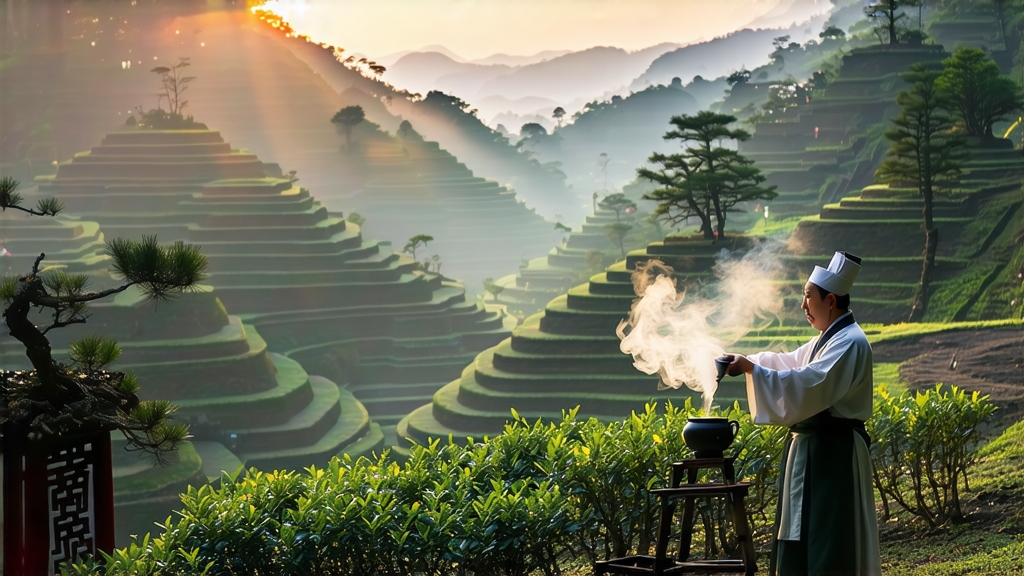
Long before English merchants coined the term “black tea,” Chinese mountain folk in the Wuyi range of northern Fujian were already finishing their spring leaves over smouldering pine boughs. The result—Lapsang Souchong—became the first fully oxidised tea ever documented, carried down precarious cliff paths on bamboo poles, floated along the Min River to the port of Xiamen, and finally loaded onto Dutch East India ships that would ignite Europe’s centuries-long tea craze. Today the same tiny village of Tongmu, population under two thousand, still guards the original gene pool of the Bohea cultivar and the secrets of its trademark smoke.
History: From Bandit Refuge to Global Commodity
The story begins in the late Ming dynasty, around 1600 CE, when Qing-uniformed bandits forced tea farmers to abandon their freshly picked leaves overnight. By morning the green leaf had oxidised to a copper colour. Rather than waste the crop, the farmers rushed the batch through withering, rolling and drying over open pine fires to mask the musty edge. To their surprise, the sweet resinous aroma delighted passing merchants who paid triple the normal price. Within decades the “smoked small-leaf” (zhengshan xiaozhong) had eclipsed the green tribute teas once favoured at the imperial court in Beijing. By 1662 Catherine of Braganza’s dowry chest included Lapsang Souchong, and London coffee houses were advertising “Souchon” at sixteen shillings a pound—more than a labourer’s monthly wage.
Terroir: Why Only Tongmu Can Birth Original Lapsang
The Wuyi massif is a UNESCO dual heritage site where 650-million-year-old granite cliffs trap morning fog, creating a 70–85 % relative humidity that lengthens withering time and concentrates amino acids. At 1,200 m elevation the temperature swings 10 °C between day and night, forcing the tea bush to produce more fragrant terpenes as a natural antifreeze. The soil is a sandy laterite rich in iron and potassium, so well-drained that roots dive three metres, absorbing subtle mineral notes that later translate into a stony sweetness on the palate. Chinese law restricts the geographical indication “Zheng Shan” to a 600 km² core zone; leaves picked even one ridge outside may be called “xiaozhong” but never “Lapsang Souchong.”
Cultivars: Three Lineages Inside One Name
- Traditional Cai Cha (mixed bush): A seed-propagated population of 7–10 heirloom varieties, plucked when three leaves and a bud reach 3.5 cm uniformity. The genetic mosaic yields a layered cup with alternating honey, longan and pine resin notes.
- Wuyi Qi Zhong (clonal Wuyi #1): Released in 1982, this cultivar was selected for higher catechin-to-theaflavin conversion, giving a deeper crimson liquor and peppery finish while still accepting smoke.
- Jin Guan Yin “Yellow Goddess”: A natural hybrid between Huang Jin Gui and Tie Guan Yin, grafted onto Bohea rootstock to survive the mountain chill. Its orchid fragrance softens the smoke, creating a modern “light smoke” style popular in Shanghai and Tokyo.
Craft: The Eight-Stage Pine Ritual
Plucking begins at Qingming festival, when morning mist still beads on the leaf. After two hours of sun-withering, trays are moved onto the second floor of a three-hundred-year-old wooden tea house whose walls are impregnated with decades of resin. Inside, a charcoal hearth burns only the heartwood of Masson pine and Chinese red pine; the temperature is held at 28 °C for 6–8 hours while artisans toss the leaves every twenty minutes to ensure even water loss. Rolling follows, but unlike orthodox CTC methods the pressure is feather-light—just enough to bruise the edges so oxidative enzymes can escape. The crucial oxidation proceeds in rattan baskets lined with wet cotton; the leaf pile never exceeds 8 cm, and every 45 minutes a master “sniffs” the rising aroma, waiting for the precise moment when green grass notes vanish and ripe fruit appears. Firing halts oxidation at 85 % using a 120 °C blast of pine smoke for three minutes; this “kills